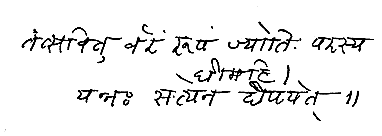The Home Rule Movement
In 1914 the First World War broke out. The British were deeply involved in this war fighting a life and death battle against the Germans. As we have seen in an earlier chapter, there was some kind of collaboration between the revolutionaries and the Germans just before the outbreak of the First World War. But it ended in failure with the death of Jyotin Mukherjee. With this we come to the end of the Second phase of the Freedom Movement. The next period from 1915 to 1920 may be described as an interlude. Mrs. Annie Besant and Tilak dominated this period.
In 1914, after six years detention in the Mandalay jail, Tilak was released. His solitary detention in Mandalay had left a deep imprint on Tilak’s personality. Tilak who was always a practical politician emerged a more cautious man. As seen earlier, the Congress had split in 1907 at the Surat session. But Tilak was not happy about the split. As remarked by Sri Aurobindo: “to no one was the catastrophe so great a blow as to Mr Tilak. He did not like the do-nothingness of the Congress but he valued it both as a national fact and for its unrealized possibilities”. He had realized the futility of revolutionary violence in the then prevailing conditions in India; he was therefore prepared to accept self-government within the British Empire as the country’s immediate political goal. Yet despite his changed political outlook the Moderates continued to distrust him. Realizing his ineffectiveness outside the Congress mainstream, he set about building a strong political base. His programme consisted of four planks: National education, Swadeshi, Boycott and Swaraj. Tilak was warmly acclaimed by the Bombay Provincial Conference in 1915 and electrified politics by his proposal of Home Rule. He set up a Home Rule League for the purpose of propagating the idea.
At the same time Annie Besant also proposed the Home Rule and created her own Home Rule League. Thus there were two Home Rule Leagues existing at the same time. These were set up in April and September 1916 respectively. Her slogan ‘England’s difficulty is India’s opportunity’ became a catchphrase in the national armoury. The educated middle class all over the country was touched by her powerful oratory and bold demand of Dominion Status on the basis of equality and rallied to the League.
Annie Besant who was of predominantly Irish lineage was a renowned theosophist. In 1889, she enrolled as a member of the Theosophical Society. Devoted and diligent, she was chosen President of the Society after the death of Col Olcott. Her interest in theosophy and Hinduism brought her to India in 1893. She lectured on Hinduism and glorified it as the fount of all religions and the cradle of civilization. Annie Besant entered the political scene in 1913 when she publicly recommended that the House of Commons set up a Standing Committee for Indian affairs. She pleaded that India be recognized as a nation and be given self-government. She started two papers: the weekly Commonwealth and the daily New India. In 1915, at Bombay she enunciated her plan to organize a Home Rule League. This was established in September 1916 after she failed to persuade Tilak to combine the League he had already established.
Tilak who wanted to join the Congress found it difficult because of the distrust of the Congress leaders. It was Annie Besant who finally persuaded them to come to reconciliation with him; the death of Gokhale and Pherozeshah Mehta made things easier.
Along with Tilak she played no small role in bringing about some kind of Hindu-Muslim unity in the Lucknow Congress in 1916.
The Lucknow Pact made in December 1916 was an agreement made by the Indian National Congress and the All-India Muslim League and adopted by the Congress at its Lucknow session on December 29 and by the League on Dec. 31, 1916. The meeting at Lucknow marked the reunion of the moderate and radical wings of the Congress and was dominated by Tilak. The pact dealt both with the structure of the government of India and with the relation of the Hindu and Muslim communities. Four-fifths of the provincial and central legislatures were to be elected on a broad franchise, and half the executive council members, including those of the central executive council, were to be Indians elected by the councils themselves. Except for the provision for the central executive, these proposals were largely embodied in the Government of India Act of 1919.
The Congress also agreed to separate electorates for Muslims in provincial council elections Apparently this pact paved the way for Hindu-Muslim cooperation and unity. However, there are many who feel that this was a wrong step and was in fact the first step in creating a permanent division between the Hindus and Muslims. The later history of India amply proves this. Sri Aurobindo had been warning of the dangers of communal representation. Here is what he wrote in 1909. “The question of separate representation for the Mohammedan community is one of those momentous issues raised in haste by a statesman unable to appreciate the forces with which he is dealing, which bear fruit no man expected and least of all the ill-advised Frankenstein who was responsible for its creation…. We will not for a moment accept separate electorates or separate representation, not because we are opposed to a large Mohammedan influence in popular assemblies when they come but because we will be no party to a distinction which recognizes Hindu and Mohammedan as permanently separate political units and thus precludes the growth of single and indivisible Indian nation. We oppose any such attempt at division whether it comes from an embarrassed Government seeking for political support or from an embittered Hindu community allowing the passions of the moment to obscure their vision of the future.”
Much later Sri Aurobindo wrote: “What has created the Hindu-Muslim split was not Swadeshi, but the acceptance of the communal principle by the Congress, (here Tilak made his great blunder), and the further attempt by the Khilafat movement to conciliate them and bring them in on wrong lines. The recognition of that communal principle at Lucknow made them permanently a separate political entity in India which ought never to have happened.”
At about the same time, most ironically, Mohammed Ali Jinnah, too opposed the idea of a separate electorate for the Muslims. In the words of Krishna Iyer: “He opposed the Muslim League's stand of favouring separate electorate for the Muslims and described it “as a poisonous dose to divide the nation against itself." He collaborated with the Congress and actively worked against the Muslim communalists, calling them enemies of the nation. He had been much influenced by the speeches of Naoroji, Mehta and Gokhale whom he adored. Naoroji as Congress President had emphasised the need for ”a thorough union of all the people" and pleaded with Hindus and Muslims to "sink or swim together. Without this union, all efforts will be in vain", he added. Jinnah was in full agreement with this view. He deprecated the contrary separatist policy advocated by the League”.
There was a certain amount of rivalry between the two Home Leagues, which made each plough their lonely furrow. But before long they joined together in a gesture of reciprocity. Many others joined including Jawaharlal Nehru. Tilak’s area of operation was mainly in Maharashtra and Karnataka, while Mrs Besant’s was generally over the South and in some pockets of Bihar, Bengal, Gujarat and Sind. The objective of the movement was to attain a system of self-government within the British Empire. The agitation made rapid strides during 1916-17 and while broadly active in many parts of the country registered noticeable progress in the South. Both Tilak and Mrs Besant engaged in extensive tours and took up educational and social work with the intention to inform and agitate the masses and involve them in the freedom struggle. Their attempt was to capture the Congress. The Home rulers argued that India’s contribution to the World War should be rewarded with some political progress. At the same time the Russian Revolution and President Wilson’s suggestion for the formation of the League of Nations gave added momentum to the demand for Home Rule. The British Government reacted in typical fashion – stern handling and suppression of the Movement terming it as sedition. A case was instituted against Tilak; he was served a notice to pay a sum of Rs 40,000. However on appeal the decision was rescinded by the High Court. In May 1916, Mrs Annie Besant forfeited her security on her paper New India. Meanwhile all attempts to persuade her to abandon the Home Rule campaign and return to England failed. On her declining to do so, she and her assistants were interned without trial. She thus emerged as the country’s foremost freedom fighter and was released in September 1917.Later in the year she was rewarded with the Presidentship of the Congress.
The British seeing that the Home Rule Movement was gaining tremendous popularity put forward a proposal to placate the Moderates within the Congress. They proposed to grant responsible government and put forward a concrete scheme for Reform in the August 1917 Declaration. In the light of this gesture, the Home Rule League decided to suspend the agitation and sent instead an all-India deputation to meet the Viceroy. The release from jail of Mrs Besant was a landmark in her career. Instead of capitalizing on the release, within a year she succeeded in completely isolating herself from the various groups in the Congress and thus forfeited all claims to leadership of the nationalist movement and the Congress. Two reasons may be adduced for this. One was that the United Front she had cobbled up of the Moderates and the Extremists was basically unstable and secondly she vigourously opposed the Passive Resistance, which then had become the chief plank of the Congress. Her inconstancy and the lack of a definite programme finally made the Congress reject her leadership. Tilak too had by this time virtually relinquished his authority; thus the Congress was almost leaderless and the Home Rule Movement had weakened beyond any hope of revival. This vacuum was filled up by Gandhi and with his advent started the next phase of the Freedom Movement.
The Home Rule Movement was not a great success. However it contributed in some ways to the Nationalist movement. Firstly, it was due to its agitation that the British promised to advance towards self-rule. Secondly, it was for the first time that there was an all-India movement with the exception of Punjab and Bengal. In Punjab, the Arya Samaj rejected the Theosophical movement of Mrs Besant and in Bengal the leadership of C.R. Das was too powerful to make a dent. Probably what led to the failure of the movement was the ambivalence in accepting passive resistance, which then was the only available plan of action. Its failure prepared the ground for the taking over of the Congress by Gandhi.
 |
The Web site and administration
does not take any responsiblities of any kind for the material published
in Books/Articles .And also the Opinions and Views published in Books/Articles
are solely of the writers and contributors.For
any Query you may directly contact them either by e-mail address or by
Mailing address.
Terms and
Condition for Publication of Book/Article



